2017 PEUGEOT 5008 fuel consumption
[x] Cancel search: fuel consumptionPage 193 of 404
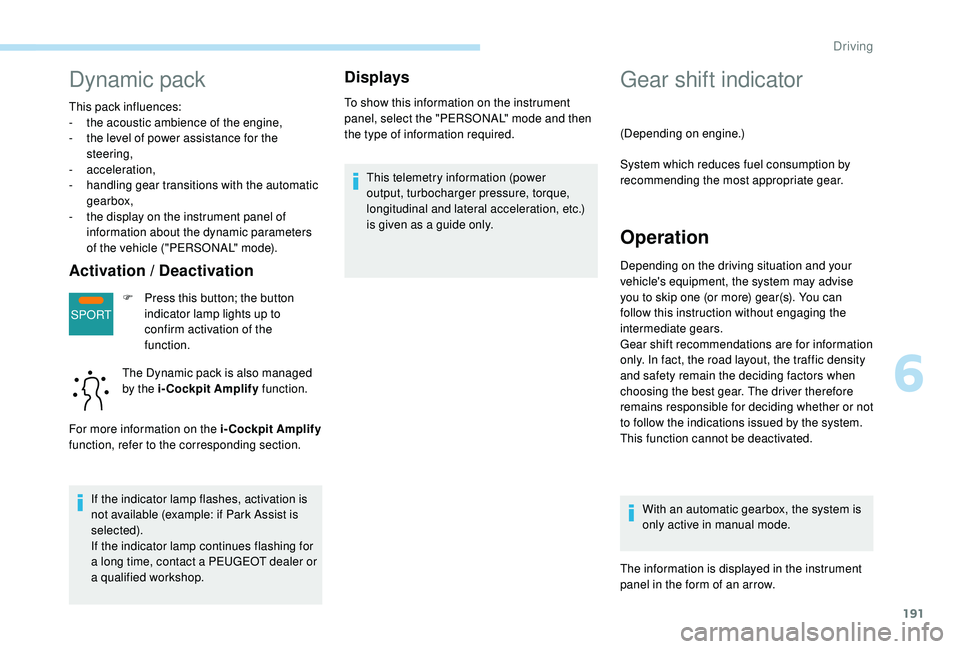
191
SPORT
Dynamic pack
This pack influences:
- t he acoustic ambience of the engine,
-
t
he level of power assistance for the
steering,
-
acceleration,
-
h
andling gear transitions with the automatic
gearbox,
-
t
he display on the instrument panel of
information about the dynamic parameters
of the vehicle ("PERSONAL" mode).
Activation / Deactivation
F Press this button; the button indicator lamp lights up to
confirm activation of the
function.
The Dynamic pack is also managed
by the i-Cockpit Amplify function.
For more information on the i-Cockpit Amplify
function, refer to the corresponding section.
If the indicator lamp flashes, activation is
not available (example: if Park Assist is
selected).
If the indicator lamp continues flashing for
a long time, contact a PEUGEOT dealer or
a qualified workshop.
Displays
To show this information on the instrument
panel, select the "PERSONAL" mode and then
the type of information required.This telemetry information (power
output, turbocharger pressure, torque,
longitudinal and lateral acceleration, etc.)
is given as a guide only.
Gear shift indicator
(Depending on engine.)
System which reduces fuel consumption by
recommending the most appropriate gear.
Operation
Depending on the driving situation and your
vehicle's equipment, the system may advise
you to skip one (or more) gear(s). You can
follow this instruction without engaging the
intermediate gears.
Gear shift recommendations are for information
only. In fact, the road layout, the traffic density
and safety remain the deciding factors when
choosing the best gear. The driver therefore
remains responsible for deciding whether or not
to follow the indications issued by the system.
This function cannot be deactivated.
With an automatic gearbox, the system is
only active in manual mode.
The information is displayed in the instrument
panel in the form of an arrow.
6
Driving
Page 194 of 404

192
With a manual gearbox, the arrow may be
accompanied by the gear recommended.
The system adapts its gear shift
recommendation according to the driving
conditions (slope, load, etc.) and the
driver’s requirements (power, acceleration,
b r a k i n g ,e t c .) .
The system never suggests:
-
e
ngaging first gear,
-
enga
ging a lower gear,
-
enga
ging reverse.Stop & Start
The Stop & Start system puts the engine
temporarily into standby – STOP mode – during
stops in the traffic (red lights, traffic jams, etc.).
The engine restarts automatically – START
mode – as soon as you want to move off.
The restart takes place instantly, quickly and
silently.
Per fect for urban use, the Stop & Start system
reduces fuel consumption and exhaust
emissions as well as the noise level when
stationary.
Operation
Going into engine STOP mode
- with a manual gearbox , at speeds below
12 mph (20 km/h) or vehicle stationary
with the PureTech 130
petrol and BlueHDi
115
and 120 Diesel versions, when you
place the gear lever in neutral and you
release the clutch pedal,
-
w
ith an automatic gearbox , vehicle
stationary, when you press the brake pedal
or put the gear selector in N mode.
The time counter aggregates the STOP mode
activation periods during a trip. It resets itself to
zero every time the ignition is switched on with
the key or the " START/STOP" button.
For your convenience during parking
manoeuvres, STOP mode is not available
for a few seconds after coming out of
reverse gear.
Stop & Start does not affect the operation
of vehicle systems such as braking, power
steering, etc.
Never refuel with the engine in STOP
mode; you must switch off the ignition with
the key or the "START/STOP" button.
This indicator lamp comes on in the
instrument panel and the engine
goes into standby automatically:
Driving
Page 197 of 404
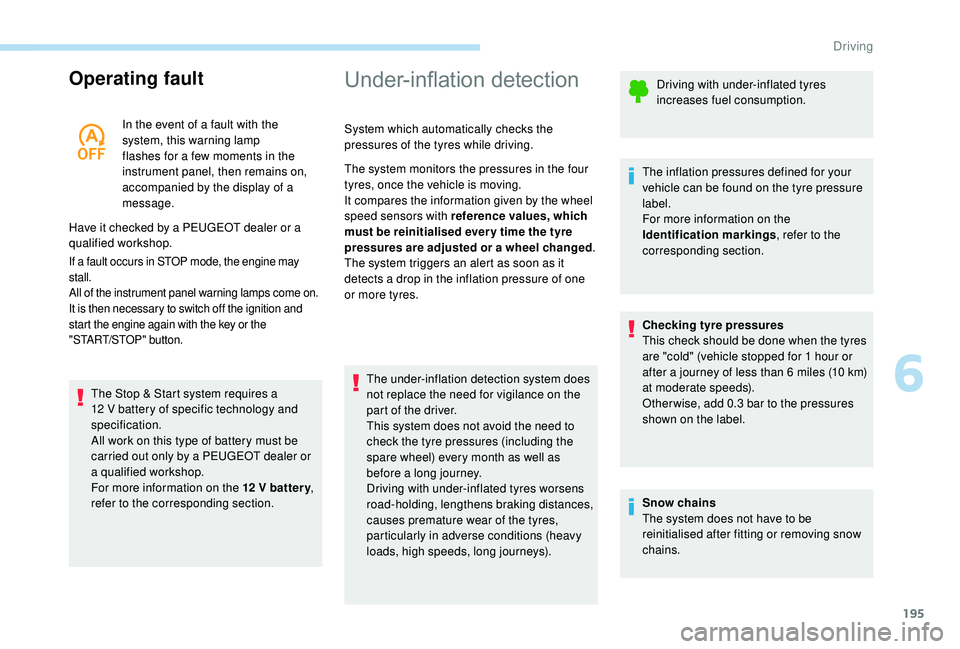
195
Operating fault
In the event of a fault with the
system, this warning lamp
flashes for a few moments in the
instrument panel, then remains on,
accompanied by the display of a
message.
Have it checked by a PEUGEOT dealer or a
qualified workshop.
If a fault occurs in STOP mode, the engine may
stall.
All of the instrument panel warning lamps come on.
It is then necessary to switch off the ignition and
start the engine again with the key or the
"START/STOP" button.
The Stop & Start system requires a
12 V battery of specific technology and
specification.
All work on this type of battery must be
carried out only by a PEUGEOT dealer or
a qualified workshop.
For more information on the 12
V batter y,
refer to the corresponding section.
Under-inflation detection
System which automatically checks the
pressures of the tyres while driving.
The system monitors the pressures in the four
tyres, once the vehicle is moving.
It compares the information given by the wheel
speed sensors with reference values, which
must be reinitialised ever y time the tyre
pressures are adjusted or a wheel changed .
The system triggers an alert as soon as it
detects a drop in the inflation pressure of one
or more tyres.
The under-inflation detection system does
not replace the need for vigilance on the
part of the driver.
This system does not avoid the need to
check the tyre pressures (including the
spare wheel) every month as well as
before a long journey.
Driving with under-inflated tyres worsens
road-holding, lengthens braking distances,
causes premature wear of the tyres,
particularly in adverse conditions (heavy
loads, high speeds, long journeys). Driving with under-inflated tyres
increases fuel consumption.
The inflation pressures defined for your
vehicle can be found on the tyre pressure
label.
For more information on the
Identification markings , refer to the
corresponding section.
Checking tyre pressures
This check should be done when the tyres
are "cold" (vehicle stopped for 1
hour or
after a journey of less than 6
miles (10 km)
at moderate speeds).
Other wise, add 0.3
bar to the pressures
shown on the label.
Snow chains
The system does not have to be
reinitialised after fitting or removing snow
chains.
6
Driving
Page 264 of 404
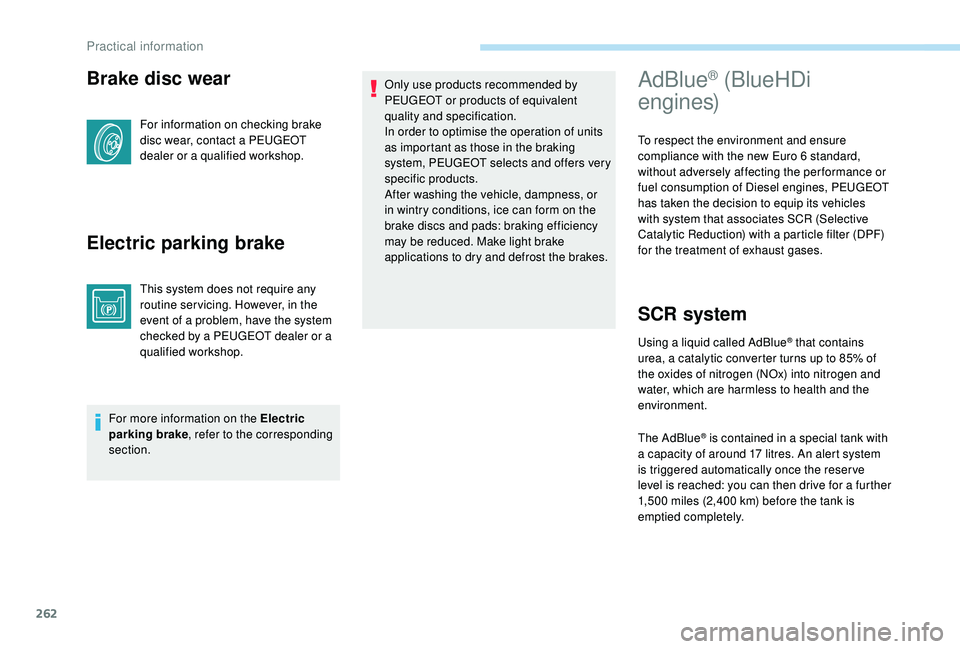
262
Brake disc wear
For information on checking brake
disc wear, contact a PEUGEOT
dealer or a qualified workshop.
Electric parking brake
This system does not require any
routine servicing. However, in the
event of a problem, have the system
checked by a PEUGEOT dealer or a
qualified workshop.
For more information on the Electric
parking brake , refer to the corresponding
section. Only use products recommended by
PEUGEOT or products of equivalent
quality and specification.
In order to optimise the operation of units
as important as those in the braking
system, PEUGEOT selects and offers very
specific products.
After washing the vehicle, dampness, or
in wintry conditions, ice can form on the
brake discs and pads: braking efficiency
may be reduced. Make light brake
applications to dry and defrost the brakes.
AdBlue® (BlueHDi
engines)
To respect the environment and ensure
compliance with the new Euro 6
standard,
without adversely affecting the performance or
fuel consumption of Diesel engines, PEUGEOT
has taken the decision to equip its vehicles
with system that associates SCR (Selective
Catalytic Reduction) with a particle filter (DPF)
for the treatment of exhaust gases.
SCR system
Using a liquid called AdBlue® that contains
urea, a catalytic converter turns up to 85% of
the oxides of nitrogen (NOx) into nitrogen and
water, which are harmless to health and the
environment.
The AdBlue
® is contained in a special tank with
a capacity of around 17 litres. An alert system
is triggered automatically once the reser ve
level is reached: you can then drive for a further
1,500
miles (2,400 km) before the tank is
emptied completely.
Practical information
Page 298 of 404
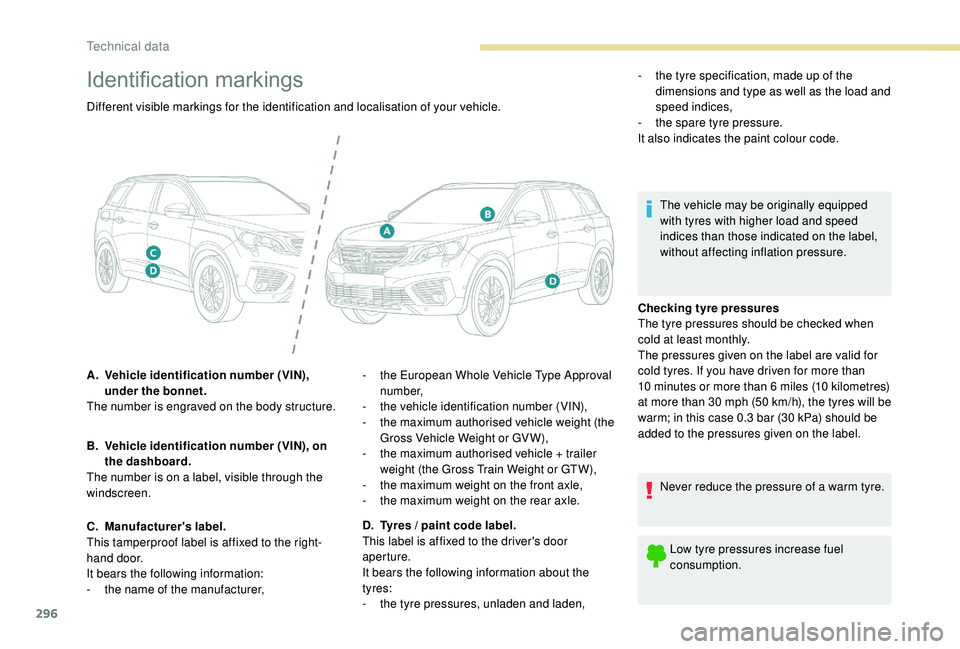
296
Identification markings
Checking tyre pressures
The tyre pressures should be checked when
cold at least monthly.
The pressures given on the label are valid for
cold tyres. If you have driven for more than
10 minutes or more than 6 miles (10 kilometres)
at more than 30
mph (50 km/h), the tyres will be
warm; in this case 0.3
bar (30 kPa) should be
added to the pressures given on the label.
Never reduce the pressure of a warm tyre.
Low tyre pressures increase fuel
consumption.
Different visible markings for the identification and localisation of your vehicle.
A.
V
ehicle identification number (VIN),
under the bonnet.
The number is engraved on the body structure.
B.
V
ehicle identification number (VIN), on
the dashboard.
The number is on a label, visible through the
windscreen.
C.
M
anufacturer's label.
This tamperproof label is affixed to the right-
hand door.
It bears the following information:
-
t
he name of the manufacturer, -
t
he European Whole Vehicle Type Approval
number,
-
t
he vehicle identification number (VIN),
-
t
he maximum authorised vehicle weight (the
Gross Vehicle Weight or GV W),
-
t
he maximum authorised vehicle + trailer
weight (the Gross Train Weight or GTW),
-
t
he maximum weight on the front axle,
-
t
he maximum weight on the rear axle.
D.
T
yres / paint code label.
This label is affixed to the driver's door
aperture.
It bears the following information about the
tyres:
-
t
he tyre pressures, unladen and laden, -
t
he tyre specification, made up of the
dimensions and type as well as the load and
speed indices,
-
t
he spare tyre pressure.
It also indicates the paint colour code.
The vehicle may be originally equipped
with tyres with higher load and speed
indices than those indicated on the label,
without affecting inflation pressure.
Technical data
Page 333 of 404

35
Select "Ambience ".
Or
" Position ".
Or
" Sound ".
Or
" Voice ".
Or
" Ringtone ".
Press " OK" to save the settings.
Modifying system settings
or Press "Settings"
to display the
primary page.
Press the " OPTIONS" button to go to the
secondary page.
Select "Screen configuration ".
Select " Animation ".
Activate or deactivate: " Automatic
scrolling ".
Select " Brightness ".
Move the cursor to adjust the
brightness of the screen and/or of
the instrument panel. or
Press "Settings"
to display the
primary page.
Press the " OPTIONS" button to go to the
secondary page.
Select "System settings ".
Initialisation of the profile selected
activates the English language by default.
Select a " Profile" (1
or 2
or 3) to associate the
" Audio settings " with it.
Select " Audio settings ".
Select "Units" to change the units of distance,
fuel consumption and temperature.
Select " Factory settings " to return to the initial
settings.
Returning the system to factory settings
activates the English language by default.
Select " System info " to display the versions of
the different modules installed in the system.
.
PEUGEOT Connect Nav
Page 363 of 404
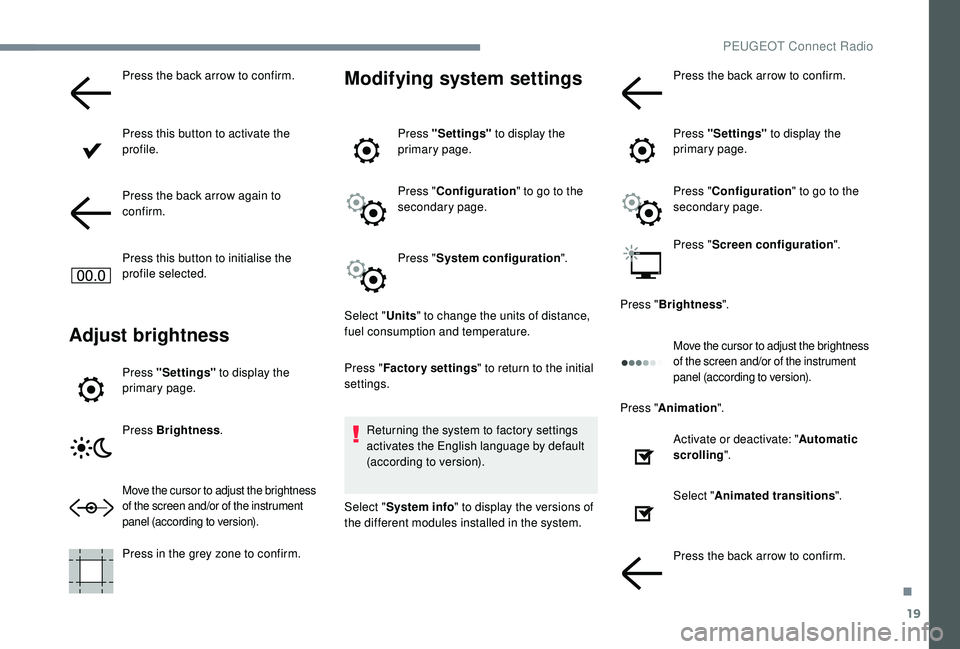
19
Press the back arrow to confirm.
Press this button to activate the
profile.
Press the back arrow again to
confirm.
Press this button to initialise the
profile selected.
Adjust brightness
Press "Settings" to display the
primary page.
Press Brightness .
Move the cursor to adjust the brightness
of the screen and/or of the instrument
panel (according to version).
Press in the grey zone to confirm.
Modifying system settings
Press "Settings" to display the
primary page.
Press " Configuration " to go to the
secondary page.
Press " System configuration ".
Select " Units" to change the units of distance,
fuel consumption and temperature.
Press " Factory settings " to return to the initial
settings.
Returning the system to factory settings
activates the English language by default
(according to version).
Select " System info " to display the versions of
the different modules installed in the system. Press the back arrow to confirm.
Press "Settings"
to display the
primary page.
Press " Configuration " to go to the
secondary page.
Press " Screen configuration ".
Press " Brightness ".
Move the cursor to adjust the brightness
of the screen and/or of the instrument
panel (according to version).
Press "Animation ".
Activate or deactivate: " Automatic
scrolling ".
Select " Animated transitions ".
Press the back arrow to confirm.
.
PEUGEOT Connect Radio
Page 397 of 404
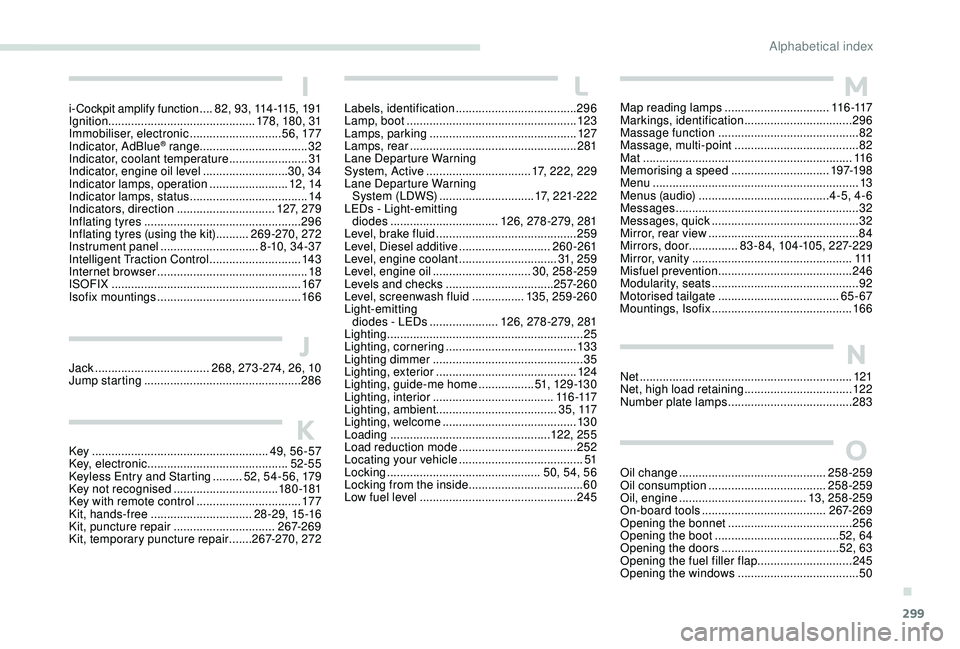
299
Key ...................................................... 49, 56-57
Key, electronic ........................................... 52-55
Keyless Entry and Starting
.........52
, 54-56, 179
Key not recognised
................................ 18
0 -181
Key with remote control
................................17
7
Kit, hands-free
............................... 2
8-29, 15 -16
Kit, puncture repair
............................... 2
67-269
Kit, temporary puncture repair
.......
267-270, 272 Map reading lamps
................................
11
6 -117
Markings, identification
.................................
296
Massage function ...........................................
82
Massage, multi-point
......................................
82
Mat
................................................................
11 6
Memorising a speed
..............................
19
7-198
Menu
...............................................................
13
Menus (audio)
........................................
4-5, 4-6
Messages
........................................................
32
Messages, quick
............................................. 3
2
Mirror, rear view ..............................................
84
Mirrors, door ...............83-84, 104 -105, 227-229
Mirror, vanity
.................................................
111
Misfuel prevention
.........................................
246
Modularity, seats
.............................................
92
Motorised tailgate
..................................... 6
5 - 67
Mountings, Isofix
...........................................
166K
J
LM
Labels, identification ..................................... 296
Lamp, boot .................................................... 123
Lamps, parking
............................................. 127
Lamps, rear
................................................... 281
Lane Departure Warning
System, Active
................................ 17, 222, 229
Lane Departure Warning System (LDWS)
............................. 17, 221-222
LEDs - Light-emitting diodes
................................. 126, 278-279, 281
Level, brake fluid
........................................... 259
Level, Diesel additive
............................260-261
Level, engine coolant
..............................31, 259
Level, engine oil
.............................. 30, 258-259
Levels and checks
..............................
...257-2 6 0
Level, screenwash fluid
................13
5, 259-260
Light-emitting diodes - LEDs
.....................126, 278-279, 281
Lighting
............................................................ 25
Lighting, cornering
........................................ 13 3
Lighting dimmer
.............................................. 35
Lighting, exterior
........................................... 124
Lighting, guide-me home
.................51, 12 9 -13 0
Lighting, interior
...............................
......11 6 -117
Lighting, ambient ..................................... 35, 117
Lighting, welcome
......................................... 13 0
Loading
................................................. 12 2, 255
Load reduction mode
.................................... 252
Locating your vehicle
...................................... 51
Locking
...............................
................50, 54, 56
Locking from the inside
...................................60
Low fuel level
................................................ 24
5
Jack
...............................
.... 268, 273-274, 26, 10
Jump starting
................................................ 286
I
i-Cockpit amplify function ....82, 93, 114 -115 , 191
Ignition ................ ............................. 178 , 18 0, 31
Immobiliser, electronic
............................56, 17 7
Indicator, AdBlue
® range ................................. 32
Indicator, coolant temperature ........................ 31
Indicator, engine oil level
.......................... 30, 34
Indicator lamps, operation
........................ 12
, 14
Indicator lamps, status
.................................... 14
I
ndicators, direction
.............................. 1 2 7, 279
Inflating tyres
................................................ 296
Inflating tyres (using the kit)
.......... 2
69-270, 272
Instrument panel
.............................. 8 -10, 34-37
Intelligent Traction Control
............................ 143
Internet browser
.............................................. 18
I
SOFIX
.......................................................... 167
Isofix mountings
............................................ 166
N
Net ................................................................. 121
Net, high load retaining .................................12 2
Number plate lamps
...................................... 283
O
Oil change ............................................. 25 8-259
Oil consumption .................................... 258-259
Oil, engine
....................................... 13, 258-259
On-board tools
...................................... 267-269
Opening the bonnet
...................................... 256
Opening the boot
...................................... 52, 64
Opening the doors
.................................... 52, 63
Opening the fuel filler flap
.............................245
Opening the windows
..................................... 50
.
Alphabetical index